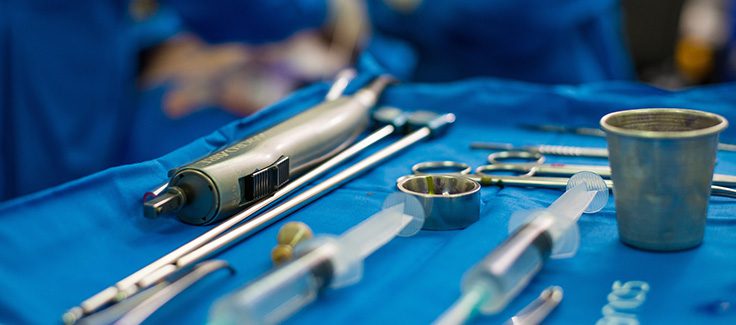The Most Popular Surgical Procedures in Colombia
The pandemic and the consequent suspension of elective surgery during the first year caused a 38.8% reduction in the total number of surgical procedures performed in Colombia in 2020, compared with the previous year.
The data were revealed by SurgiScope, Global Health Intelligence’s analysis tool for the surgery sector. In 2019, surgical procedures in the various medical specialties totaled more than eleven million (11,589,876). The number dropped sharply to little over seven million (7,091,321), showing the high number of people who were left untreated for different surgical treatment pathologies because of the COVID pandemic and the fear for the safety of doctors and patients at a time when the disease was still not under control with vaccines or knowledge about the new virus.
In the second year of the pandemic, 2021, with more controls against the virus and a return to a more normal health-care situation, surgical procedures performed in Colombia (8,548,893) saw an upturn of 20.6% compared to the previous year, but did not reach the 2019 level.
The information from SurgiScope, analyzed in combination with the data from HospiRank, signals that there are major opportunities for dynamism in Colombia’s surgery sector.
HospiRank, Global Health Intelligence’s classification system highlighting the best equipped hospitals in Latin America, reports that Colombia has 3,644 hospitals, 57% of which are private and 43% are public. The number of hospital beds is 76,915, and there are 3,976 operating rooms.
Overview of the Colombian hospital sector
The country’s need to provide its population with greater access to surgical care is one of the vital conversations for the transformation of the health system currently being addressed in Colombian society. One of its deficits is precisely the low ratio of operating rooms to hospitals in the country, compared with other countries in the region. This, combined with a backlog in surgical procedures resulting from the suspension of elective surgery during the pandemic, evidences the need to give the sector a boost.
As HospiRank 2022 shows, throughout the Latin American region, hospital infrastructure comprises 21,951 hospitals, 1,244,837 beds, 58,699 operating rooms, and a ratio of two doctors per thousand inhabitants. On the other hand, Colombia has a lower proportion of operating rooms per hospital compared to other countries in the region, with just 1.2 operating rooms, below Latin America’s regional average of 1.4 per hospital. Brazil leads, with an average of 4.3, followed by Mexico, with 2.2.
SurgiScope is a tool that provides detailed information about opportunities with respect to surgical procedures. As Guillaume Corpart, CEO of GHI, says: “This key tool shows the dimension of activities in the health ecosystem. It provides visibility, not only of the number of procedures, but of the types of procedures being performed, their complexity, and whether they are in the public or private sector. These data can paint a representative portrait of the health ecosystem. No health systems in the world are perfect, but armed with reliable data, we can make the best decisions to improve the systems we have. And this is central to the health policies of all governments in the region.

Surgical procedures and medical devices in Colombia
Cancer surgery. For cancer treatment, in terms of both the diagnostic aspects and treatment with and without surgery, the country has a leading institution. It is important to note that when the HospiRank came out, the Luis Carlos Sarmiento Angulo Cancer Treatment and Research Center (CTIC) had not yet opened (see Latin America’s Newest Hospitals), so it was not included in HospiRank 2022. An investment of more than 1.5 billion pesos went into CTIC. It has 120 hospitalization units, four radiotherapy bunkers, nine operating rooms, and 176 rooms with hospital beds, among other features, making it the country’s most advanced center in this category.
Better operating rooms. Other notable facilities in terms of operating rooms and equipment are the El Tesoro branch of the El Rosario Clinic in Medellín; the Las Américas Auna Clinic in the same city; and the Valle de Lili Foundation in Cali.
Robotic surgery. Traditional health care equipment aside, there are also hospitals with robotic surgery systems, the vast majority of which are located in Bogotá, with the exception of the Foscal Clinic in Floridablanca, and the Neurological Institute of Colombia in Medellín. In Bogotá, the entities mentioned with robotic equipment were the clinics of Marly, Nogales, Shaio, and Santa Fe, and the National Cancerology Institute.
More organ transplants. Although they have not reached the levels prior to the novel coronavirus pandemic, these surgical procedures did see an increase in 2021.
Augmented reality. With regard to technological innovation, surgical procedures were also impacted by the trend of incorporating artificial intelligence and simulation. In Colombia, they are implementing an augmented-reality technology that maps a patient’s lower body to improve the processes and thereby perform much more precise surgery. Dr. Fernando Hakim Daccach, head of the Neurosurgery Department of the Santafé Foundation in Bogotá, is among the professionals with expertise in this technology. A ZEISS microscope and augmented reality are used to generate a three-dimensional image, which then becomes an important guide during the surgery because it allows a view of the specific points involved.
Hospitals with the most operating rooms. The Colombian hospital with the highest number of operating rooms is the Central Military Hospital, with 24 rooms. This is followed by the Foscal Clinic in Santander, with 23, and the Valle de Lili Foundation in Cali, with 20.
Better infrastructure for patients. With regard to the biggest infrastructure to receive patients, the Valle de Lili Foundation leads with 454 inpatient beds and 553 outpatient beds. This is followed by Hospital Universitario Mayor de Méderi of Bogotá, with 751 and 83 beds respectively.
Toward safer surgical procedures. Colombia is part of the World Health Organization’s “Safe Surgery Saves Lives” program. The WHO reports that, each year, unsafe surgical procedures cause complications in around 25% of surgery patients. Of these, roughly seven million have significant complications, one million of whom die during or immediately after the surgery. According to the annual report of the United States Joint Commission on Accreditation of Healthcare Organizations, 3,548 sentinel events were reviewed. Of these, 12.80% occurred in the wrong place, 12.50% had postoperative complications, and 1.60% were anesthesia-related. In addition, the IBEAS study, conducted in five Latin American countries (Argentina, Colombia, Costa Rica, Mexico, and Peru), mentions that the prevalence of adverse events was 10.50%. Among the five most frequent were those due to complications related to surgery or procedures, and 55% of these were preventable. As a result, the WHO passed Resolution WHA55.18, creating a surgical safety checklist (SSC) as part of the “Safe Surgery Saves Lives” program, to ensure safe surgical processes, minimizing the most common preventable risks that endanger the life and well-being of surgery patients, and highlighting the role of the nursing team.

The Colombian health system
The Colombian health system is characterized by a contributory (private) scheme and a subsidized (free) scheme. Both schemes provide universal coverage, equal access to medicines, surgical procedures, medical services, dental services, etc. In Colombia, the contributory scheme is a system where workers contribute part of their wages in order to have health coverage for them and their families. This means people who have an employment relationship and the ability to pay, such as formal employees and the self-employed, and pensioners.
The subsidized scheme, meanwhile, is a system where the poorest people, with an inability to pay, have access to health services through a state subsidy.
The Colombian health system comprises an extensive social security sector, and a decreasing, exclusively private, sector. At its core is the General System of Social Security in Health (SGSSS) with its two schemes: the contributory scheme (RC) and the subsidized scheme (RS). RC affiliates are salaried workers and pensioners, and self-employed workers with incomes equal to or above a minimum wage. RS affiliates are all the people who are unable to pay. In 2010, coverages were 39.7% and 51.4% of the total population, respectively. The Special Schemes (REs) affiliate employees of the Military Forces, the National Police, the state-owned oil company Empresa Colombiana de Petróleos (ECOPETROL), the teaching profession, and the public universities.
In 2010, just 4.3% of the population remained outside the social security health system. The RC operates on the basis of contributions from affiliates. The RS operates on the basis of a cross-subsidy from the RC plus other tax funds collected from general taxes. Affiliation with the SGSSS is mandatory, and is done through what are known as health promotion entities (EPSs). These may be public or private, and are responsible for offering, at a minimum, the Mandatory Health Plan (POS), and the POS-S for those affiliated with the RS. The EPSs channel the funds collected through contributions to the Solidarity and Guarantee Fund (FOSYGA), which returns to the EPSs an amount equivalent to the risk-adjusted capitation payment unit (UPC), depending on the number of affiliates they have. The capitated payment in the RS is similar (although not risk-adjusted), and is known as UPC-S. The health care providers are service-provider institutions (IPSs), which may or may not be integrated with the EPSs, but which are in any case contracted by them.
The exclusively private sector is used by those on top incomes who, even if they are contributing to an EPS, prefer to take out private insurance or visit private physicians.
There is a portion of the population on middle incomes who feel the need to resort to private care services by making out-of-pocket payments, owing to a lack of coverage or of timely access to the SGSSS.
Next steps
Contact us to learn more about surgical procedures and equipment in Colombia and other Latin American countries. Solutions such as Hospirank, HospiScope and SurgiScope provide the information you need to understand the field of surgeries and hospitals in the countries within the region.





